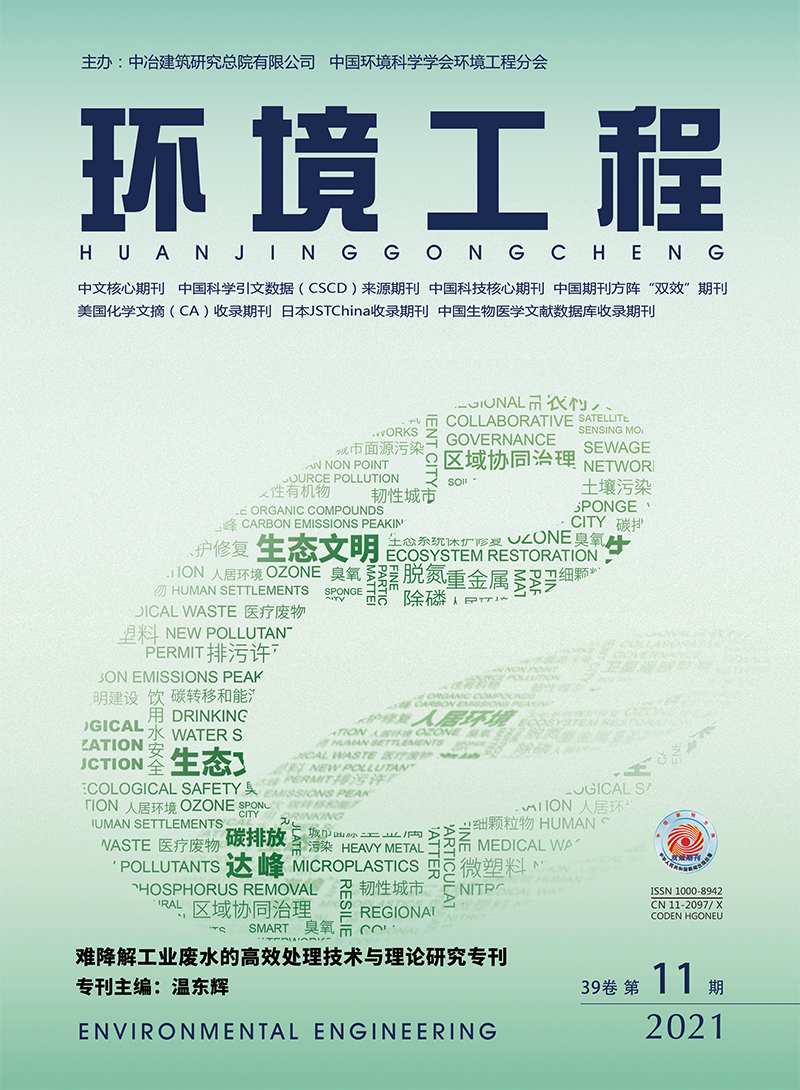| [1] |
LONG B B, YE J E, YE Z, et al. Cr(Ⅵ) removal by Penicillium oxalicum SL2:reduction with acidic metabolites and form transformation in the mycelium[J]. Chemosphere, 2020, 253:126731.
|
| [2] |
ZHANG L, NIU W Y, SUN J, et al. Efficient removal of Cr(Ⅵ) from water by the uniform fiber ball loaded with polypyrrole:static adsorption, dynamic adsorption and mechanism studies[J]. Chemosphere, 2020, 248:126102.
|
| [3] |
ZHAO Z Y, AN H, LIN J, et al. Progress on the photocatalytic reduction removal of chromium contamination[J]. Chemical Record, 2019, 19(5):873-882.
|
| [4] |
ZHENG Y R, LIU S G, DAI C M, et al. Study on the influence mechanism of underground mineral element Fe(Ⅱ) on Cr(Ⅵ) transformation under subsurface and groundwater interaction zones[J]. Environmental Sciences Europe, 2020, 32(1):62.
|
| [5] |
PARANI S, OLUWAFEMI O S. Selective and sensitive fluorescent nanoprobe based on AgInS2-ZnS quantum dots for the rapid detection of Cr (Ⅲ) ions in the midst of interfering ions[J]. Nanotechnology, 2020, 31(39):395501.
|
| [6] |
TABATABAEI S, RAD B F, BAGHDADI M. Semicontinuous enhanced electroreduction of Cr(Ⅵ) in wastewater by cathode constructed of copper rods coated with palladium nanoparticles followed by adsorption[J]. Chemosphere, 2020, 251:126309.
|
| [7] |
XIA S P, SONG Z L, JEYAKUMAR P, et al. A critical review on bioremediation technologies for Cr(Ⅵ)-contaminated soils and wastewater[J]. Critical Reviews in Environmental Science and Technology, 2019, 49(12):1027-1078.
|
| [8] |
张立剑, 周睿. 活性炭材料对Cr(Ⅵ)的吸附研究[J]. 水处理技术, 2018, 44(8):49-52.
|
| [9] |
石林, 段睿, 杨翠英, 等. 常温还原铁氧体法处理含铬废水[J]. 环境工程学报, 2015, 9(8):3883-3888.
|
| [10] |
梅丽娟, 殷仕学, 朴哲, 等. 一种耐Cr(Ⅵ)微生物筛选新方法[J]. 环境科学与技术, 2019, 42(5):41-45.
|
| [11] |
ZHENG Y Q, CHENG B, YOU W, et al. 3D hierarchical graphene oxide-NiFe LDH composite with enhanced adsorption affinity to Congo red, methyl orange and Cr(Ⅵ) ions[J]. Journal of Hazardous Materials, 2019, 369:214-225.
|
| [12] |
冯西平, 冯婷希. 亚硫酸氢钠处理电镀废水中铬的实验研究[J]. 电镀与环保, 2018, 38(1):64-67.
|
| [13] |
MOHAMED A, YU L, FANG Y, et al. Iron mineral-humic acid complex enhanced Cr(Ⅵ) reduction by Shewanella oneidensis MR-1[J]. Chemosphere, 2020, 247:125902.
|
| [14] |
CAI Y Y, HAN Z P, LIN X C, et al. Study on removal of phosphorus as struvite from synthetic wastewater using a pilot-scale electrodialysis system with magnesium anode[J]. Science of the Total Environment, 2020, 726:138221.
|
| [15] |
陈日耀. 纳米SiO2改性海藻酸钠/壳聚糖双极膜的制备与表征[J]. 高校化学工程学报, 2012, 26(1):160-164.
|
| [16] |
LIU Y X, KE X, ZHU H Q, et al. Treatment of raffinate generated via copper ore hydrometallurgical processing using a bipolar membrane electrodialysis system[J]. Chemical Engineering Journal, 2020, 382:122956.
|
| [17] |
HERRERO-GONZALEZ M, DIAZ-GURIDI P, DOMINGUEZ-RAMOS A, et al. Highly concentrated HCl and NaOH from brines using electrodialysis with bipolar membranes[J]. Separation and Purification Technology, 2020, 242:116785.
|
| [18] |
İPEKÇI D, KABAY N, BUNANI S, et al. Application of heterogeneous ion exchange membranes for simultaneous separation and recovery of lithium and boron from aqueous solution with bipolar membrane electrodialysis (EDBM)[J]. Desalination, 2020, 479:114313.
|
| [19] |
KRAVTSOV V, KULIKOVA I, MIKHAYLIN S, et al. Alkalinization of acid whey by means of electrodialysis with bipolar membranes and analysis of induced membrane fouling[J]. Journal of Food Engineering, 2020, 277:109891.
|


 Login
Login Register
Register E-alert
E-alert






 DownLoad:
DownLoad: